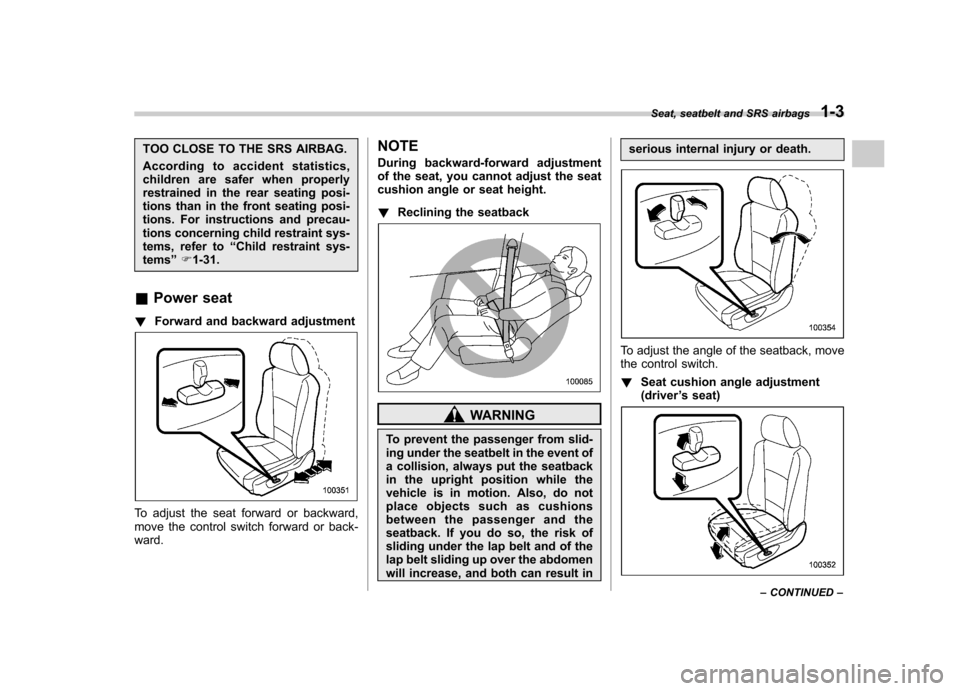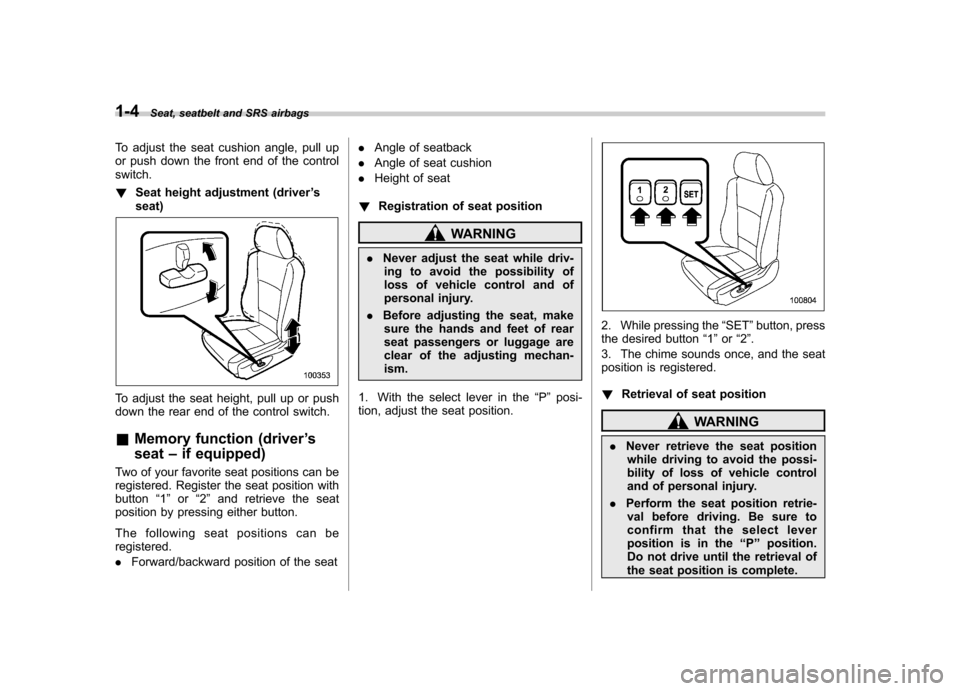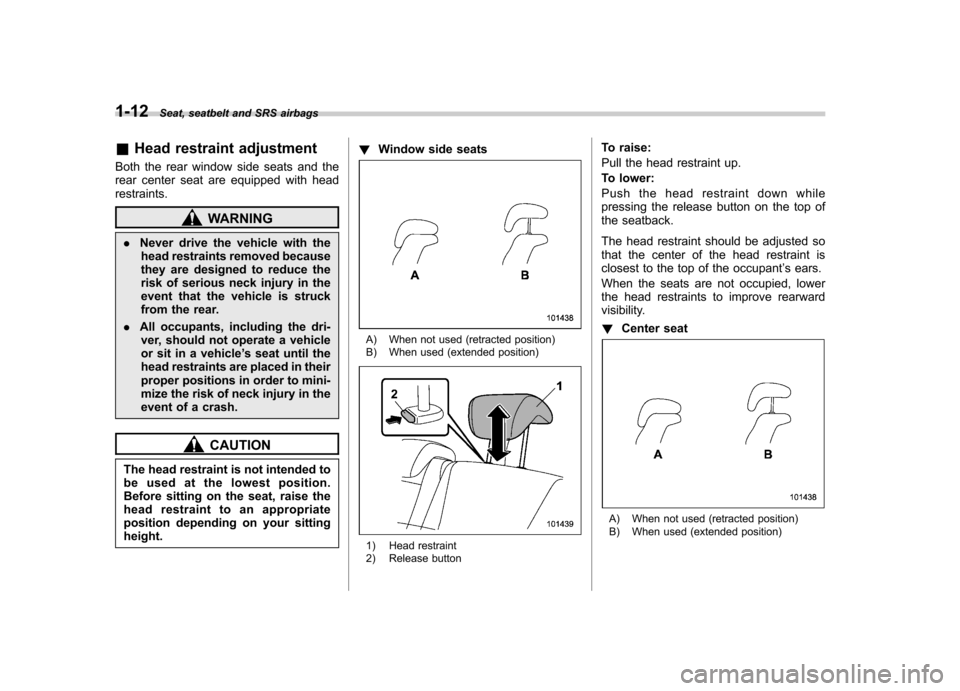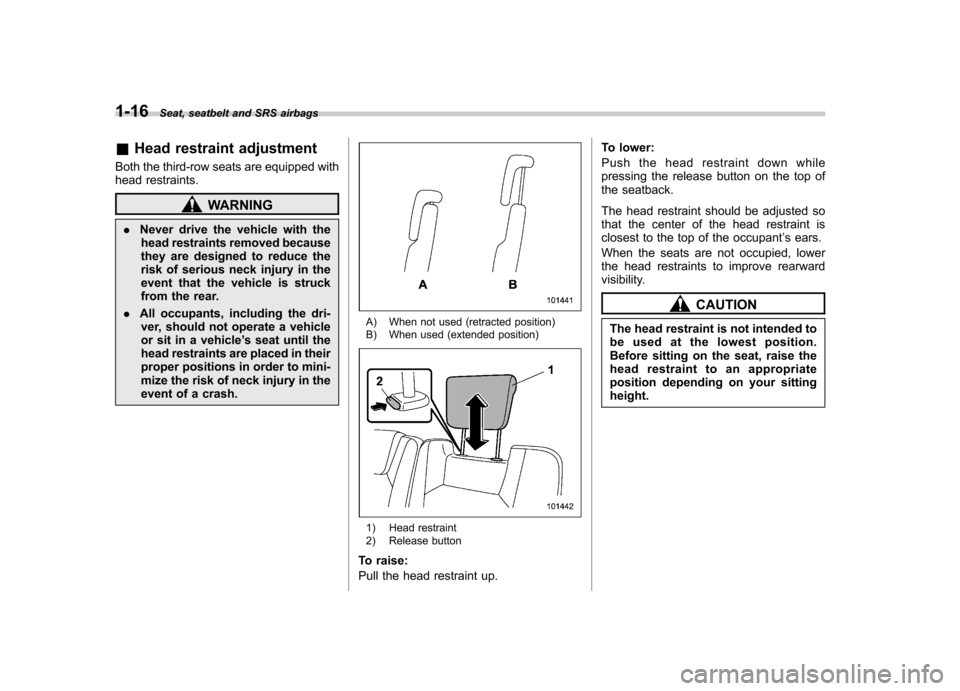2011 SUBARU TRIBECA height adjustment
[x] Cancel search: height adjustmentPage 30 of 422

TOO CLOSE TO THE SRS AIRBAG.
According to accident statistics,
children are safer when properly
restrained in the rear seating posi-
tions than in the front seating posi-
tions. For instructions and precau-
tions concerning child restraint sys-
tems, refer to“Child restraint sys-
tems ”F 1-31.
& Power seat
! Forward and backward adjustment
To adjust the seat forward or backward,
move the control switch forward or back-ward. NOTE
During backward-forward adjustment
of the seat, you cannot adjust the seat
cushion angle or seat height. !
Reclining the seatback
WARNING
To prevent the passenger from slid-
ing under the seatbelt in the event of
a collision, always put the seatback
in the upright position while the
vehicle is in motion. Also, do not
place objects such as cushions
between the passenger and the
seatback. If you do so, the risk of
sliding under the lap belt and of the
lap belt sliding up over the abdomen
will increase, and both can result in serious internal injury or death.
To adjust the angle of the seatback, move
the control switch. !
Seat cushion angle adjustment (driver ’s seat)
Seat, seatbelt and SRS airbags 1-3
– CONTINUED –
Page 31 of 422

1-4Seat, seatbelt and SRS airbags
To adjust the seat cushion angle, pull up
or push down the front end of the controlswitch. !Seat height adjustment (driver ’s
seat)
To adjust the seat height, pull up or push
down the rear end of the control switch. & Memory function (driver ’s
seat –if equipped)
Two of your favorite seat positions can be
registered. Register the seat position withbutton “1 ” or “2 ” and retrieve the seat
position by pressing either button.
The following seat positions can be registered. . Forward/backward position of the seat .
Angle of seatback
. Angle of seat cushion
. Height of seat
! Registration of seat position
WARNING
. Never adjust the seat while driv-
ing to avoid the possibility of
loss of vehicle control and of
personal injury.
. Before adjusting the seat, make
sure the hands and feet of rear
seat passengers or luggage are
clear of the adjusting mechan-ism.
1. With the select lever in the “P ” posi-
tion, adjust the seat position.
2. While pressing the “SET ”button, press
the desired button “1 ” or “2 ”.
3. The chime sounds once, and the seat
position is registered. ! Retrieval of seat position
WARNING
. Never retrieve the seat position
while driving to avoid the possi-
bility of loss of vehicle control
and of personal injury.
. Perform the seat position retrie-
val before driving. Be sure to
confirm that the select lever
position is in the “P ” position.
Do not drive until the retrieval of
the seat position is complete.
Page 39 of 422

1-12Seat, seatbelt and SRS airbags
&Head restraint adjustment
Both the rear window side seats and the
rear center seat are equipped with headrestraints.
WARNING
. Never drive the vehicle with the
head restraints removed because
they are designed to reduce the
risk of serious neck injury in the
event that the vehicle is struck
from the rear.
. All occupants, including the dri-
ver, should not operate a vehicle
or sit in a vehicle ’s seat until the
head restraints are placed in their
proper positions in order to mini-
mize the risk of neck injury in the
event of a crash.
CAUTION
The head restraint is not intended to
be used at the lowest position.
Before sitting on the seat, raise the
head restraint to an appropriate
position depending on your sittingheight. !
Window side seats
A) When not used (retracted position)
B) When used (extended position)
1) Head restraint
2) Release button To raise:
Pull the head restraint up.
To lower:
Push the head restraint down while
pressing the release button on the top of
the seatback.
The head restraint should be adjusted so
that the center of the head restraint is
closest to the top of the occupant
’s ears.
When the seats are not occupied, lower
the head restraints to improve rearward
visibility. ! Center seat
A) When not used (retracted position)
B) When used (extended position)
Page 43 of 422

1-16Seat, seatbelt and SRS airbags
&Head restraint adjustment
Both the third-row seats are equipped with
head restraints.
WARNING
. Never drive the vehicle with the
head restraints removed because
they are designed to reduce the
risk of serious neck injury in the
event that the vehicle is struck
from the rear.
. All occupants, including the dri-
ver, should not operate a vehicle
or sit in a vehicle ’s seat until the
head restraints are placed in their
proper positions in order to mini-
mize the risk of neck injury in the
event of a crash.
A) When not used (retracted position)
B) When used (extended position)
1) Head restraint
2) Release button
To raise:
Pull the head restraint up. To lower:
Push the head restraint down while
pressing the release button on the top of
the seatback.
The head restraint should be adjusted so
that the center of the head restraint is
closest to the top of the occupant
’s ears.
When the seats are not occupied, lower
the head restraints to improve rearward
visibility.
CAUTION
The head restraint is not intended to
be used at the lowest position.
Before sitting on the seat, raise the
head restraint to an appropriate
position depending on your sittingheight.
Page 414 of 422

Active head restraint................................................. 1-6
Forward and backward adjustment ............................. 1-3
Head restraint adjustment ......................................... 1-5
Lumbar support ....................................................... 1-7
Memory function ...................................................... 1-4
Power seat .............................................................. 1-3
Reclining ................................................................. 1-3
Seat height adjustment ............................................. 1-4
Fuel ........................................................................... 7-2
Economy hints ......................................................... 8-2
Filler lid and cap ...................................................... 7-3
Gauge .................................................................... 3-8
Requirements .................................................. 7-2, 12-3
Fuses ...................................................................... 11-35
Main fuse ............................................................. 11-36
Fuses and circuits .................................................... 12-10
G
GAWR (Gross Axle Weight Rating) .............................. 8-12
Glove box ................................................................... 6-6
GVWR (Gross Vehicle Weight Rating) .......................... 8-12
H
Hazard warning flasher ........................................... 3-5, 9-2
Head restraint adjustment Front seat ............................................................... 1-5
Second-row seat .................................................... 1-12
Third-row seat ....................................................... 1-16
Headlight Beam leveler ......................................................... 3-29
Bulb replacement .................................................. 11-37 Bulb wattage
........................................................ 12-13
Control switch ........................................................ 3-26
Flasher .................................................................. 3-27
Indicator light ......................................................... 3-21
High beam indicator light ............................................. 3-20
High/low beam change (dimmer) .................................. 3-27
HomeLink
®Wireless Control System ............................ 6-17
Hook Coat ..................................................................... 6-12
Convenient tie-down ............................................... 6-16
Shopping bag ........................................................ 6-13
Towing and tie-down ............................................... 9-15
Horn ......................................................................... 3-43
Hose and connections ............................................... 11-10
I
Ignition switch ............................................................. 3-3
Light ...................................................................... 3-4
Illuminated entry ......................................................... 2-10
Illumination brightness control ...................................... 3-28
Immobilizer ................................................................. 2-3
Indicator light (security indicator light) ................. 2-4, 3-19
Indicator light
Cruise control ................................................ 3-20, 7-33
Cruise control set ........................................... 3-21, 7-33
Front fog light ......................................................... 3-21
Headlight ............................................................... 3-21
High beam ............................................................. 3-20
Immobilizer ............................................................ 3-19
Security .......................................................... 2-4, 3-19
Select lever/Gear position ........................................ 3-20Index
14-5